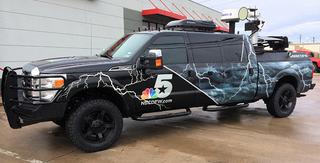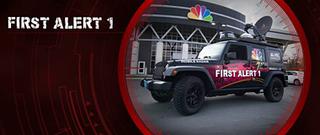ENG Trucks: A Conversation With AMT’s Tom Jennings

Storm-chaser truck with radar built for KXAS in Dallas-Fort Worth
ALEXANDRIA, VA.—There has been a revolution in television acquisition gear in the past 10 years, as equipment has become smaller, faster and more capable. In the meantime, there are more ways than ever to report news stories from the field, including cellular 4G systems that are available in places that even microwave can’t reach.
What has this equipment revolution meant in terms of ENG trucks? Like other equipment categories, can trucks do more than ever, or are they shrinking to mirror the size of the gear fitted into them?
To find out, BE Extra talked to Tom Jennings, president and co-founder of Accelerated Media Technologies in Auburn, Mass. Jennings has more than 25 years of ENG/SNG truck design and manufacturing experience, and has been at the heart of all the recent changes in truck design and technology.
BE Extra: As gear gets smaller, does that mean trucks get smaller as well? Is the typical news truck today any different size-wise than it was 15 or 20 years ago? What accounts for the difference/similarity?
Jennings: Yes, trucks are getting significantly smaller. Gone are the days of large box trucks in 90 percent of the markets, replaced by smaller van-sized units based on the new Ram ProMaster and full-size Ford Transit trucks. There is also a revolution of smaller SUV-based trucks that support microwave, cell bonding and Ka-band satellite on platform ranging from Jeep Wranglers to Ford Explorers… up to GM Suburbans.
BE Extra: When the BAS relocation happened a few years ago, truck microwave gear was switched from analog to digital COFDM. This made reception in difficult locations generally easier, and a telescoping mast was discussed as no longer necessary in many cases. Is there still a case for a telescoping mast? If so, why?
Get the TV Tech Newsletter
The professional video industry's #1 source for news, trends and product and tech information. Sign up below.

ENG/weather truck for WFSB in Hartford, Conn.
Jennings: Masts are still vital to ENG. In urban applications, the thought around the BAS transition was the new COFDM modulation would eliminate the need for masts due its ability to thrive in city canyons using the “bounce shot” technique. The fact is you still need to get your transmit antenna above obstructions to hit your receive site both in urban and rural applications. We are still using line-of-sight technology.
BE Extra: Is it standard today for news trucks to have a means of handling cellular/4G signals? What are one or two ways that cellular/4G is integrated into trucks?
Jennings: AMT uses all brands of cellular bonding gear but both LiveU and Dejero have advanced dynamic encoders that aggregate to Viasat’s Ka-band satellite service making for extremely robust and low-cost connectivity. Two out of three trucks we are building have this transmission mode onboard.
BE Extra: With 4G cellular bonding systems so simple, relatively cheap and license free, do news organizations need to bother with microwave anymore?
Jennings: Don’t count microwave out quite yet. Although cellular technology and Ka-band satellite have added flexibility to news departments, microwave is a licensed asset that TV stations own. At NAB 2015, AMT won Best of Show with our partners General Dynamics and Immedia for our ENGenesis system that allows up to 10 trucks to transmit in the same channel simultaneously and bi-directionally. Additionally, ENGenesis can have a cellular layer to allow private cellular networks to be deployed. Although mast sizes may come down on some trucks, microwave is not going away any time soon.
BE Extra: With a lot of heavy gear installed in a truck (such as racks, roof-mount antennas, masts, etc.), what’s done to the truck itself to ensure safety and drivability?
Jennings: With technology getting smaller, the tendency of some groups is to try and build trucks internally or by smaller truck vendors. In reality, the interface between new technology and the OEM chassis is more complex than ever. Power systems, tracking systems, high-idle systems and higher centers of gravity for conventional passenger vehicles require special skills and OEM certifications, as well as an intimate knowledge of the OEM ECM systems. The conversions are less expensive overall but take a definite skillset to implement. Fortification to springs and structure is only one part of the problem. Often times specific pull tests, crash tests and ECM programming must be adjusted to accomplish a safe platform.

Storm-chaser truck with radar built for WVIT in New Britain-Hartford, Conn.
BE Extra: What are a couple of unusual or special requests you’ve received for a truck? What was done to meet the request? Did it involve any special engineering or design on AMT’s part?
Jennings: Trucks are far more than ENG or SNG trucks anymore. They are being built for special applications. Storm Trackers, Fire Chasers and various other weather vehicles are being fashioned in Jeep Wranglers, Subaru Foresters, stretched pickup trucks, etc. The trucks themselves become an extension of the newsroom— “personified,” if you will. They are used for both promotional and news events to connect the stations to their audiences. WVIT and KXAS (Both NBC O&O stations) recently designed a stretch Ford E250 and Jeep Wrangler as storm chasers. Both contained industry-first mobile radar, weather telemetrics, Ka-band satellite, microwave and cellular bonding (LiveU and Dejero) for hyper-local reporting of weather.
BE Extra: Is there anything else that we should know about building a modern news truck?
Jennings: Our advice to anyone that is building a new truck is to be well informed. Keep the trucks as low as possible and as small as possible to achieve the mission. There will always be a need for full-size trucks, but smaller trucks allow greater mobility, greater design flexibility and can be operated by less-experienced operators.
